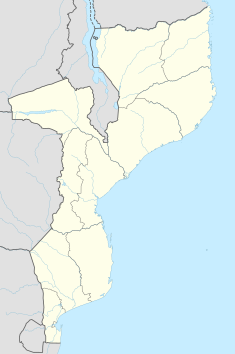Dam in Chicamba, Manica Province
| Chicamba Hydroelectric Power Station | |
|---|---|
 | |
| Country | Mozambique |
| Location | Chicamba, Manica Province |
| Coordinates | 19°09′21″S 33°08′42″E / 19.15583°S 33.14500°E / -19.15583; 33.14500 |
| Purpose | Power |
| Status | Operational |
| Owner(s) | Government of Mozambique |
| Operator(s) | Electricidade de Mozambique |
| Dam and spillways | |
| Impounds | Revue River |
| Reservoir | |
| Normal elevation | 625 m (2,051 ft) |
| Commission date | 1968 & 2017 |
| Turbines | 2 x 22 MW (Francis) |
| Installed capacity | 44 MW (59,000 hp) |
The Chicamba Hydroelectric Power Station is an operational 44 megawatts (59,000 hp) hydroelectric power project in Mozambique. The power plant, first established in 1968, underwent rehabilitation and upgrades in 2017, raising its generating capacity, from 38.4 megawatts to 44 megawatts, with prolongation of its lifespan by another thirty years.
Location
The power station is located at Chicamba, across the Ruvue River, in Manica Province, near the international border between Mozambique and Zimbabwe. This location is approximately 50 kilometres (31 mi), by road, south-east of the town of Manica, where the provincial capital is located. Chicamba is located about 250 kilometres (155 mi), by road, northwest of the city of Beira, the nearest large city. The geographical coordinates of Chicamba HPP are: 19°09'21.0"S, 33°08'42.0"E (Latitude:-19.155833; Longitude:33.145000).
Overview
Chicamba Power Station (44 megawatts) and the nearby Mavuzi Hydroelectric Power Station (41 megawatts), both located in Manica Province were intended to supply electricity to the provinces of Manica and neighboring Sofala, supplemented with power obtained from the Cahora Bassa Dam.
Due to their age; Chicamba HPP was commissioned in 1968 and Mavuzi HPP was established in 1957, much of the original hardware is not available on the market and maintenance was a challenge in the 21st century. For a period of 3.5 years, beginning in 2013 until February 2017, both stations underwent refurbishment and upgrades, with the contractor manufacturing new hardware to replace what could not be purchased on the open market.
Refurbishment and improvements
The refurbishment contract was awarded to a consortium comprising Rainpower, a Norwegian supplier of hydroelectricity generating hardware and Cegelec, a French engineering company. Other entities included Hydrokarst, a French company that socializes in underwater inspection and installations.
Construction costs
The rehabilitation bill in 2017 for both Chicamba HPP and Mavuzi HPP is quoted as US$120 million (€90 million at that time). The sources of funding are illustrated in the table below:
| Rank | Funder | Amount in Euros | US $ Equivalent | Percentage | Notes |
|---|---|---|---|---|---|
| 1 | Swedish International Development Cooperation Agency | 30.00 million | 40.0 million | 33.3 | Loan |
| 2 | KfW | 15.8 million | 21.2 million | 17.6 | Loan |
| 3 | Agence Française de Développement (AFD) | 44.2 million | 58.8 million | 49.1 | Loan |
| All | 90 million | 120 million | 100.00 | Total |
See also
References
- Rajan Gupta (21 February 2015). "Profile of Chicamba Hydroelectric Power Plant Mozambique". Los Alamos, New Mexico, United States: Global Energy Observatory. Retrieved 8 March 2021.
- ^ Club of Mozambique (28 February 2017). "Mavuzi and Chicamba power stations in Manica: US$120 million rehabilitation complete". Maputo: Club of Mozambique. Retrieved 8 March 2021.
- "Road Distance Between Manica, Mozambique And Gimo, Mozambique" (Map). Google Maps. Retrieved 8 March 2021.
- "Road Distance Between Beira, Mozambique And Bandula, Mozambique" (Map). Google Maps. Retrieved 8 March 2021.
- "Location of Chicamba Hydroelectric Power Station, Manica Province, Mozambique" (Map). Google Maps. Retrieved 8 March 2021.
- ^ Hyydrokarst (November 2017). "Mavuzi and Chicamba hydroelectric power plants rehabilitation" (PDF). Paris, France: Hydrokarst. Retrieved 8 March 2021.
External links
- Mozambique Sets Its Sights On Hydroelectric Development As of 24 April 2017.